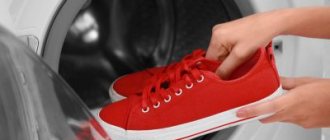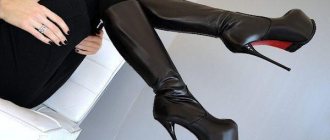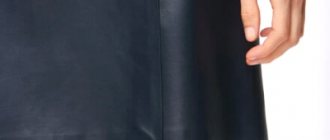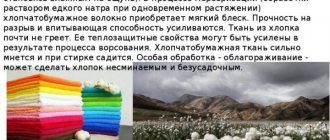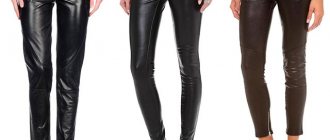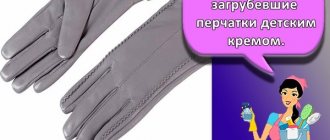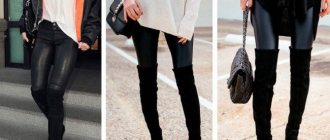Leather trousers always remain in trend, because they not only look impressive and stylish, but also have the most useful property for clothing - practicality. Being a completely natural material, leather is durable and resistant to stains. It would seem that you can wear leather products forever. But even such a universal thing needs special care, which, first of all, concerns washing. How to wash leather pants so that they last a long time?
Can leather trousers be washed?
Unfortunately, in 95% of cases, any professional will advise you not to spoil your favorite wardrobe item, but to take it to the dry cleaner. This is because leather products cannot be washed either in a machine or by hand. Even such a practical material is fraught with many risks, to eliminate which it is necessary to take into account the type of leather, its color, quality and degree of contamination.
If the option of dry cleaning is not feasible, then the housewife has no choice - she will have to cope on her own. Then her obligatory task will be to study tips on the proper care of a leather product, as well as become familiar with the manufacturer’s recommendations indicated on the label. At home, you can tidy up leather pants in 3 ways:
- wash by hand;
- use the machine wash method;
- clean only the area of contamination.
But before you begin any of the methods, you need to prepare your clothes.
Preparing for washing
- It is better to select a washing method based on information from the label; if washing in a machine is prohibited, you can try to clean the item manually;
- ordinary washing powder and bleach are prohibited - such products are dangerous for leather goods;
- Do not wash leather items of different colors together, as they may fade;
- It is recommended to use special detergents that fix color and soften water;
- decorative elements - rhinestones, sequins, appliqués and zippers - must be protected so that they do not spoil the skin or fall off;
- To increase washing efficiency, the product is soaked until the material is saturated with water.
Now it's time to move on to the main process - washing.
How to wash leather pants completely
If a full wash is inevitable, then to avoid unpleasant consequences you need to approach the process with the utmost caution:
- Hand wash is carried out in warm water, at a temperature of no more than 30 degrees. Before you start washing, soak the product for 5-10 minutes. The main thing is to prevent excessive swelling of the material. After this, the dirt is carefully wiped off with a sponge or soft brush dipped in soapy water. The skin will not tolerate rough mechanical impact, so it is important not to overdo it! After this, the fabric is rinsed with warm water and dried. Do not squeeze with your hands!
- In the machine, leather trousers are washed in the “Wool” or “Delicate Wash” mode. Recommended temperature is 30 degrees. When setting the rinse and spin mode, the number of revolutions should correspond to 300, or even better - “without spin”.
Washing machine: pros and cons
It is best not to wash leather and leatherette items at all. These materials do not like excess moisture and with frequent washing can crack, stretch and fade. If you decide to wash your clothes, it is better to do it by hand.
Various clothes are made from leather of different textures and densities. For example, a leather raincoat or jacket is usually made of thick leather and is designed to be worn in the rain or even snow. It is better to dry clean them if possible. But leather pants or a skirt have a softer texture and thinner leather. They can be washed if specified on the label.
If there are icons on the product that allow you to wash the item in a machine, then it is better to do so. To do this, you should choose a temperature of no more than 35 degrees. At higher rates, the products will definitely become deformed and lose their appearance. The spin should also be turned off completely or the regulator should be set to the minimum number of revolutions (300-400). Washing gels are less likely to leave streaks. The machine drying mode must be turned off. Heating will cause cracks and abrasions.
It is better to dry the product either horizontally or on a hanger. Choose a room without excessive humidity, direct exposure to sunlight or strong heat.
This recommendation also applies to leather shoes. It is not recommended to wash it. In addition to capricious leather or fragile leatherette, your favorite shoes may contain fittings and adhesives that are easily deformed by water and even more so when scrolled in a drum. The same applies to headwear - caps with thick visors, berets and hats.
If you need to clean an area of the product
It is not at all necessary to put the material at risk and wash the pants completely if the contamination is limited to a small area. It’s safer to use a leather stain remover spray or a special cloth that will gently remove the stain without harming the product itself.
If there are no professional leather cleaners in the house, folk advice in the form of simple and affordable remedies will help:
- acid – citric or acetic;
- dishwashing liquid;
- special purified gasoline for lighters;
- beaten egg white (for light-colored trousers).
Detergent is used to prepare a regular soap solution. The enzymes in the dishwasher help deal not only with dirt, but also with greasy stains. For easy cleaning, the pants are placed on a horizontal surface, and the dirty area is treated with a sponge or soft brush.
Lemon juice or vinegar is diluted in half with water, and then the area of contamination is wiped with the resulting solution. The fabric is wiped dry, removing any remaining acid, then the skin is lubricated with cream to moisturize.
Gasoline will help remove greasy stains. To do this, wipe stains on trousers with a cotton pad slightly dipped in gasoline. After this, it is simply necessary to moisturize the material, since gasoline is very drying to the skin.
Subtleties of cleaning
In order to remove any dirt from clothes or shoes at home, it is not necessary to wash the product completely. It is enough to treat the problem area. When washing by hand, do not twist or wrinkle or rub the clothing too much, damaging the fibers of the leather or substitute.
For machine washing, in addition to a special gel, a pre-diluted soap solution or baby shampoo without dyes are suitable. To ensure that the water drains out as much as possible, after washing you can leave the product in the drum for half an hour.
To remove a stain from any kind of contamination, lay the item on the table and whip up a foam of laundry soap. Using a cloth or sponge, apply it to the damaged area. Leave the composition on the material for 2-5 minutes and wipe dry with a clean cloth. If this does not help or the stain remains from a specific substance, radical measures are required.
Table vinegar will help remove stubborn dirt. It must be diluted with water in a ratio of 1 to 1. After this, apply the composition to the contaminated surface with a cotton swab or sponge. Try not to wet your skin excessively. Remove any remaining residue with a cloth.
The same method can be used by using lemon juice. In most cases, alcohol or refined gasoline can remove the contamination. Apply them to the skin using a cotton pad and then remove any remaining residue with a tissue.
Felt pens and markers are a real disaster for people who have small children. Both your clothes and your favorite leather sofa can suffer from them. You can wash them using any alcohol solution by wiping the stain with a cotton pad soaked in it. You can also resort to using hairspray. Spray it on the dirt and wipe with a clean cloth.
Delicious recipe! Garnish for chicken wings
It is more difficult to remove the paste from a ballpoint pen. The ink eats into the skin. Mix alcohol and acetic acid and treat the stain with a cotton swab. The second effective method is to use tape or sticky tape. Glue it to the problem area and tear it off sharply. Remaining surface dirt can be removed using a regular eraser.
White upholstery and clothing should be cleaned very carefully, being careful not to rub the stain. You can beat chicken egg white and dilute it with milk. Treat the contaminated area with the resulting mixture.
Permanent markers can be a big problem and won't respond to alcohol. In this case, there is an extraordinary method - to resort to treatment with suntan lotion or repellent. Apply the product to the stain and wait 5 minutes. Then remove with a rag and dry the item thoroughly.
Traces of grease or oil can be effectively removed using chalk powder. Sprinkle it on the stain and leave for at least 20 hours. The grease will be absorbed into the chalk, and after that all that remains is to clean the product from the surface. This method is good for dirty nubuck or suede shoes. You can also use flour instead of chalk.
If the oil stain is fresh, you should try to remove it with a sponge soaked in a water solution of dishwashing liquid. Wipe the area with product and wipe dry. For old stains, add a drop of ammonia to the soap solution. Another assistant can be white spirit and gasoline. When working with them, it is better to line the inside of the product with a clean white cloth so that excess solutions are absorbed into it.
Dark items should be treated with these products with greater care than light-colored clothing and upholstery. Gasoline and white spirit can discolor a poorly painted surface and leave streaks.
Medicines, such as potassium permanganate, iodine, brilliant green, tend to eat into the tissue very strongly. Leather in this case is no exception. These substances leave bright and noticeable traces that immediately catch the eye. Lemon juice and alcohol can help here. It is recommended to clean clothes and furniture from iodine stains using nail polish remover. Use cotton wool soaked in it to wipe the stain until it disappears.
You can get rid of stains on light leather products in this way:
- Rub the stain with lemon juice;
- Dilute the starch with water to a paste and apply it to the stain;
- Hold for a while and remove the mixture with a napkin;
- Apply lemon juice again and then starch slurry. This must be done until the stain disappears. This way you can treat both sofas and shoes. Your favorite leather boots or sneakers will be clean and refreshed again.
Clothing that comes into contact with human skin may become shiny over time. Black shiny marks may appear on the lining of the boots. And your favorite bag or backpack will shine with shabby handles. Alcohol works well to remove such stains from colored items.
Treat the greasy area with a sponge soaked in it, and then wipe with a cotton pad with lemon juice. After this, lubricate the product with glycerin. This method is also suitable for cleaning faux leather items.
How to style white leather trousers?
Light skin requires more careful treatment, since the owner of such clothing has two tasks: to avoid deformation of the material and to preserve the color. To clean white trousers, resourceful ladies use baby soap at home, as well as regular shampoo:
- A regular soap solution is prepared from shampoo or soap, to which a few drops of ammonia are added.
- Dip a sponge into the solution, wring it out, and then wipe off the dirt.
- Wipe off any remaining soapy water with a damp cloth.
If the stain cannot be removed, then treat it with whipped egg white, and after drying, carefully polish it with a soft, light-colored woolen cloth.
How to dry leather pants?
Genuine leather does not tolerate spinning or rough drying in a machine, as this inevitably leads to creases in the material. Therefore, in order to dry leather pants, you will also have to follow strict rules that will help keep the product in its original form:
- Leather clothes are dried on hangers or on any flat surface;
- it is necessary to avoid exposure of the material to sunlight, so the product is dried at home at room temperature (normally it does not exceed 20-22 degrees);
- so that water does not flow down the skin and the material dries evenly, you can put a towel or cotton cloth on top;
- You cannot hang trousers on heating devices, as uneven heating and drying of the material will lead to its deformation;
- After drying, the product is treated with a special product to moisturize the skin.
Once your leather trousers are dry, they can benefit from ironing. Caution will not hurt when working with the iron, because it should not come into direct contact with the skin. To avoid this, use paper or thin cotton fabric.
Types of material
Thanks to various methods of processing leather, many types of leather have appeared with different decorative and technical characteristics. Genuine leather is divided into:
- Smooth. Due to its most natural appearance and low processing, leather is one of the most expensive. The highest demands are placed on raw materials.
- Aniline and semi-aniline leather are minimally processed to improve their quality. Previously, it was coated with aniline dyes, but over time this method was abandoned due to its non-environmental friendliness.
- Nappa is a smooth material processed with dyes and resins. It has dirt- and moisture-proof properties, therefore it is used in the manufacture of shoes.
- Laika. It is made from the skins of small cattle. The material is unusually soft; gloves are made from it.
- Embossed leather. The embossing processing method helps budget leathers imitate luxurious and expensive ones (snake, python, etc.)
Delicious recipe! Ticket to adulthood
- Varnish. Its main feature is the coating with synthetic varnish to impart the necessary decorative properties. Due to processing, the material loses its environmental friendliness and ability to breathe, but its spectacular appearance makes it very popular for the production of clothing, shoes and accessories.
- With polyurethane surface. Impressive processing and giving the material various shades and relief patterns makes it attractive to the fashion industry. Moisture-repellent properties are highly valued in the shoe industry.
- Suede leather. It is obtained by processing animal fat. Its delicate velvety surface makes it one of the favorite types of leather among consumers, despite the high risk of damage from various factors.
- Nubuck is similar to suede in its decorative qualities, but due to sanding with a fine abrasive, it has almost imperceptible pile. Its qualities are much worse than suede, and it loses its attractive appearance much faster.
- Velours. The skins of valuable animals are not used for production. During the processing process, the surfaces of the material are ground on both sides. Velor feels like suede, but is significantly inferior in quality.
- Shagreen has a pimply surface. Roughness can be natural or achieved through vegetable and quartz tanning.
- Parchment is a very ancient type of leather. Rawhide material is used in the production of musical instruments, hand-made decorative accessories, and expensive books.
- Shora is made from thick types of hides by fat tanning. It is dense and flexible.
- Split. In the case of thick animal hides, they are sometimes separated into several layers for different uses. This saves material. The upper layers are used to make shoes, and the lower layers are used to make velor.
- Pressed. It is difficult to call this type natural. All waste from leather production is pressed with polymer additives and cheap and not very high-quality leather materials are obtained.
Leatherette has long ceased to be associated with something cheap, low-quality and unprestigious due to the fact that recently they have learned to give it a very aesthetic appearance, which can easily compete with its natural counterpart.
Types of artificial leather:
- Microfiber is made from fibers coated with polyester. The material is breathable and repels moisture. This is facilitated by the porosity of the coating. Microfiber products are washable.
- PVC leather. In this case, various additives and plasticizers are applied to the fibrous layer with polyester, which give the coating any appearance and properties. Decorative characteristics, long service life and ease of maintenance make PVC material popular in use. But due to its low environmental friendliness, it attracts mainly furniture manufacturers.
- PU leather (or polyurethane). This is a recent development, consisting of a mix of genuine leather and other materials. The textile base is sandwiched with a low-quality leather layer and covered with polyurethane. This composition is environmentally safe, breathable and resistant to various mechanical stress and temperature changes.
- Eco-leather is now on everyone’s lips. Outerwear, furniture, bags and much more are made from it. This is a two-layer material, where the base is textile or synthetic fibers, and the surface layer is made of polyurethane. This is a hypoallergenic material, resistant to all kinds of influences, that perfectly imitates natural leather.


